
The black-tailed skimmer is a dragonfly belonging to the family Libellulidae.

Gynacantha is a genus of dragonflies in the family Aeshnidae. The females have two prominent spines under the last abdominal segment. This gives the genus name and the common name two-spined darners; they are also known as duskhawkers.

Tramea is a genus of dragonflies in the family Libellulidae, the skimmers and perchers. Species of Tramea are found in tropical and subtropical regions around the globe. They typically have colored bases to their otherwise translucent hindwings. In particular when they fly, this creates the impression of their carrying bags at the start of their abdomens. They are known commonly as saddlebags or saddlebags gliders.

Anax guttatus, the pale-spotted emperor or lesser green emperor, is a dragonfly of the family Aeshnidae.

Tonyosynthemis ofarrelli, more commonly known as the slender tigertail, is a species of Odonata from the family Synthemistidae. It is found in Queensland, Australia, along the eastern coast. They tend to live along or near freshwater streams or rivers, which is also where Odonata tend to lay their eggs.

Tonyosynthemis claviculata, commonly known as the clavicle tigertail, is a species of dragonfly. They are found in Queensland, Australia, along streams and rivers, or near the eastern Australian coast and drainage basins.
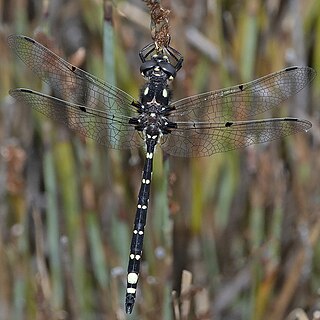
Synthemiopsis gomphomacromioides, also known as the Tasmanian spotwing, is a species of dragonfly from southern and north-western Tasmania, Australia. It is the only species in the genus Synthemiopsis and has also been placed in its own tribe, Synthemiopsini. R. J. Tillyard, who first described it, considered it intermediate between the Australian genus Synthemis and the Chilean Gomphomacromia. He had material from swamps around Cradle Mountain, at about 4,000 feet (1,200 m) altitude, and from Flowerdale Creek near Wynyard. Synthemiopsis gomphomacromioides flies rapidly over the swamps and often sits on reeds. It occurs together with Synthemis tasmanica, a similar but duller-coloured species.

Diplacodes trivialis is a species of dragonfly in the family Libellulidae known as the chalky percher or ground skimmer. It is found in China, Japan, India and southwards to New Guinea and Australia.

Gynacantha dravida, also known as Indian duskhawker or brown darner, is a species of dragonfly in the family Aeshnidae. It is found in India and Sri Lanka.

Indolestes tenuissimus is a species of damselfly in the family Lestidae, commonly known as the slender reedling. It is found in north-eastern Australia, New Guinea and on Aru.

Tramea loewii, the common glider, is a species of dragonfly in the Libellulidae family. It is found in the Cocos Islands, Moluccas, Lesser Sunda Islands, New Guinea, New Caledonia, Australia, and the western Pacific. Since 2005, Tramea loewii has also been recorded in New Zealand.

Austroaeschna unicornis is a species of dragonfly in the family Telephlebiidae, known as the unicorn darner. It is found in eastern Australia, from Brisbane to Tasmania and around Adelaide in South Australia, where it inhabits rivers and streams.

Anaciaeschna jaspidea is a species of dragonfly in the family Aeshnidae, commonly known as the Australasian duskhawker and Rusty darner. It widely distributed from India through Australia to the Pacific.

Austrogynacantha is a genus of dragonfly in the family Aeshnidae. Austrogynacantha heterogena, commonly known as the Australian duskhawker, is the only known species of this genus which is found in Australia and New Caledonia.
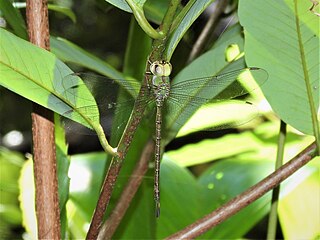
Gynacantha dobsoni is a species of dragonfly in the family Aeshnidae, known as the lesser duskhawker. It inhabits ponds and swamps and is found in northern Australia.

Gynacantha kirbyi is a species of dragonfly in the family Aeshnidae, known as the slender duskhawker. It is found in northern Queensland, Australia, the Maluku Islands, Tanimbar and New Guinea.

Gynacantha mocsaryi is a species of dragonfly in the family Aeshnidae, known as the paddle-tipped duskhawker. It is found in northern Queensland, Australia, the Maluku Islands and New Guinea.
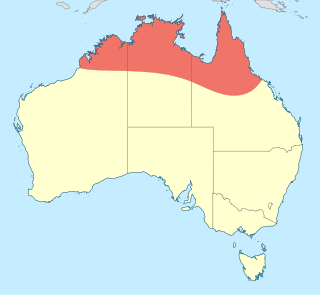
Gynacantha nourlangie is a species of dragonfly in the family Aeshnidae, known as the cave duskhawker. It inhabits pools in caves in northern Australia.
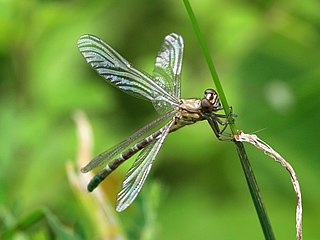
Hemigomphus comitatus is a species of dragonfly of the family Gomphidae, known as the zebra vicetail. It is endemic to northern Queensland, Australia, where it inhabits streams and rivers.
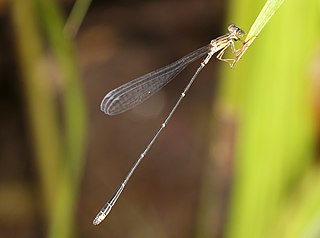
Oristicta filicicola is a species of damselfly belonging to the family Isostictidae. Until 2017 it was the only species of the genus Oristicta. Commonly known as a slender wiretail, it is a slender and dull-coloured damselfly of medium-size. It is endemic to north-eastern Australia, where it inhabits streams in rainforests.





























